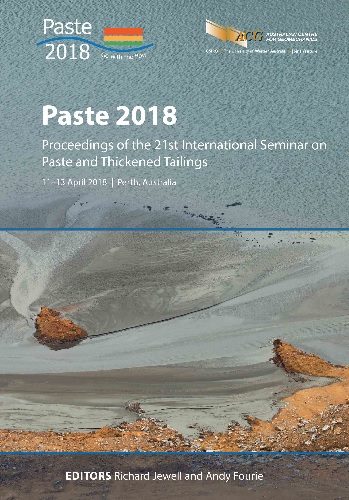Evaluating the shear resistance and ultimate dewatering performance of polymer-treated tailings

|
Authors: Boxill, L; Costine, A; Fawell, P; Catling, M; Bellwood, J |
DOI https://doi.org/10.36487/ACG_rep/1805_22_Boxill
Cite As:
Boxill, L, Costine, A, Fawell, P, Catling, M & Bellwood, J 2018, 'Evaluating the shear resistance and ultimate dewatering performance of polymer-treated tailings', in RJ Jewell & AB Fourie (eds), Paste 2018: Proceedings of the 21st International Seminar on Paste and Thickened Tailings, Australian Centre for Geomechanics, Perth, pp. 277-290, https://doi.org/10.36487/ACG_rep/1805_22_Boxill
Abstract:
Anionic copolymers have been used to enhance the dewatering and strength development properties of a wide range of tailings substrates around the mining world for at least two decades. The evaluation and selection of polymer treatment candidates for field application is often based on results obtained from a series of screening experiments to satisfy specified key performance indicators (KPIs). However, if the screening protocol or stated KPIs fail to account for the shear environment the treated tailings will experience during polymer dosing and prior to deposition, what often results is the incorrect selection of the polymer to achieve the desired dewatering and performance criteria post-deposition. Results from several laboratory-scale screening experiments are used to demonstrate how tailings (both analogues and industrial samples), dosed with the same polymer(s), can exhibit widely different characteristics when subjected to distinct shear conditions. This paper will also show how polymer selection would change depending on whether results from conventional screening criteria were used versus results obtained from an expanded screening protocol that accounts for some of the shear characteristics of the tailings treatment and deposition environment.
Keywords: tailings polymer treatment, topological mixing, controlled shear, conditioning time
References:
Beier, N, Wilson, W, Dunmola, A, & Sego, D 2013, ‘Impact of flocculation-based dewatering on the shear strength of oil sands fine tailings’, Canadian Geotechnical Journal, vol. 50, no. 9, pp. 1001–1007.
Boxill, L 2016, The Impact of Fabric and Surface Characteristics on the Engineering Behaviour of Polymer-Amended Mature Fine Tailings, PhD dissertation, University of British Columbia, Vancouver.
Costine, A, Lester, D, Fawell, P & Chryss, A 2014, ‘Shear isn't mixing: how to build larger aggregates using chaotic advection for accelerated dewatering’, in RJ Jewell, AB Fourie, PS Wells and D van Zyl (eds), Proceedings of the 17th International Seminar on Paste and Thickened Tailings, InfoMine Inc., Vancouver, p. 644.
Costine, A, Cox, J, Travaglini, S, Lubansky, A, Fawell, P & Misslitz, H 2016, ‘Influence of polymer molecular weight in low and high solids tailings applications’, in S Barrera and RJ Jewell, (eds), Proceedings of the 19th International Seminar on Paste and Thickened Tailings, Gecamin, Santiago, chapter 4, paper 2.
Costine, A, Cox, J, Travaglini, S, Lubansky, A, Fawell, P & Misslitz, H 2017, ‘Variations in the molecular weight response of anionic polyacrylamides under different flocculation conditions’, Chemical Engineering Science, vol. 176, pp. 127–138.
Farrow, JB & Warren, LJ 1993, ‘Measurement of the size of aggregates in suspension’, in B Dobias (ed.), Coagulation and Flocculation - Theory and Application, Marcel Dekker, New York, pp. 391–426.
Finn, MD & Thiffeault, JL 2011, ‘Topological optimization of rod-stirring devices’, SIAM Review, vol. 53, no. 4, pp. 723–743.
Francois, R, van Haute, A & Winderickx, G 1981, ‘The influence of kinetic process parameters in flocculation and floc characteristics’, Practical Theory of Flocculation Process: Proceedings of a Joint Seminar, pp. 103–118.
Happel, J & Brenner, H 1973, Low Reynolds Number Hydrodynamics, Noordhoff International Publishing, Leyden.
Heath, AR, Fawell, PD, Bahri, PA & Swift, JD 2002, ‘Estimating average particle size by focused beam reflectance measurement (FBRM)’, Particle & Particle Systems Characterization, vol. 19, no. 2, pp. 84–95.
Hogg, R, Lutsky, M & Suharyono, H 1995, ‘A simulation model for thickening of flocculated, fine-particle suspensions’, in JA Herbst (ed.), Proceedings of the XIX International Mineral Processing Congress – Physical & Chemical Processing, vol. 2, Society for Mining, Metallurgy & Exploration, Englewood, pp. 81–86.
McConnachie, GL & Liu, J 2000, ‘Design of baffled hydraulic channels for turbulence-induced flocculation’, Water Research, vol. 34, pp. 1886–1896.
McFarlane, A, Mensah, J & Bremmell, K 2006, ‘Optimizing flocculation and dewatering of clay dispersions via flocculant chemistry, temperature and pulp shear’, Proceedings of the 23rd International Mineral Processing Congress, pp. 1,655–1,660.
Thermo Haake GmbH 2017, RheoWin Pro, Thermo Haake GmbH, Karlsruhe.
Usher, SP, De Kretser, RG & Scales, PJ 2001, ‘Validation of a new filtration technique for dewaterability characterization’, AICHE Journal, vol. 49, no. 7, pp. 1561–1570.
Wells, PS, Revington, A & Omotoso, O 2011, ‘Mature fine tailings drying – technology update’, in RJ Jewell and AB Fourie (eds), Proceedings of the 14th International Seminar on Paste and Thickened Tailings, Australian Centre for Geomechanics, Perth, pp. 155–166.
© Copyright 2024, Australian Centre for Geomechanics (ACG), The University of Western Australia. All rights reserved.
View copyright/legal information
Please direct any queries or error reports to repository-acg@uwa.edu.au
View copyright/legal information
Please direct any queries or error reports to repository-acg@uwa.edu.au



